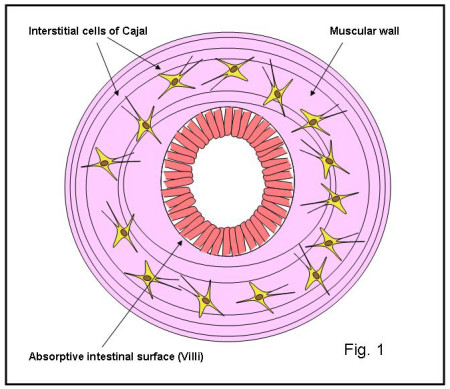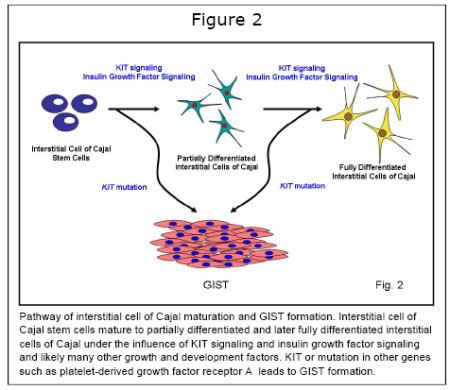Interstitial cells of Cajal are pacemaker cells, similar to the pacemaker cells of the heart, which cause the heart to beat regularly. Interstitial cells of Cajal beat rhythmically when stimulated, which is critical to their function. They are present in the wall of the gut and facilitate communication between the nervous system and the smooth muscle of the gut wall (Figure 1). When the signal arrives from the nervous system to the interstitial cells of Cajal that a person has eaten, the interstitial cells of Cajal begin beating rhythmically and tell the smooth muscle cells within the wall of the gut to contract in a rhythmic and coordinated fashion. This results in a coordinated and rhythmic set of contractions of the gut known as peristalsis, which propels food along the entire length of the digestive tract. Without the interstitial cells of Cajal, food would sit in your esophagus and would not go anywhere and that would be a disaster. I am sure you are appreciating the interstitial cells of Cajal a lot more now.
The interstitial cells of Cajal were studied in relative obscurity for over 100 years, that is, until the discovery that gastrointestinal stromal tumors (GIST) arise from interstitial cells of Cajal or an interstitial cell of Cajal-like precursor cell.
 Cancers arise from normal cells within the body that acquire genetic mutations which cause them to lose control over growth and cell division. Interstitial cells of Cajal are dependent on a protein known as KIT for their development and maintenance. The interstitial cells of Cajal produce a lot of KIT because it is a very important protein for them. KIT is a receptor tyrosine kinase, which means that it has a portion that is outside of the cell and another part that is inside of the cell. The part that is outside of the cell has a receptor that binds to another protein known as stem cell factor or KIT ligand. Other cells in the area of the interstitial cells of Cajal produce stem cell factor to try to send messages to the interstitial cells of Cajal. The messages basically tell the interstitial cells of Cajal to mature and grow or stop growing and so forth. Once KIT finds stem cell factor, it “turns on” the portion of the receptor that is inside the cell, known as the kinase domain. The kinase domain is the mechanism that allows KIT to talk to other proteins inside the cell to tell them to turn “on” or “off” which in the end, results in modification of cellular behavior. When an interstitial cell of Cajal acquires a KIT mutation that permanently turns KIT “on”, even in the absence of stem cell factor, then the cell will divide incessantly without any rhyme or reason. When this happens, a GIST is formed. Therefore, a GIST can be formed by an interstitial cell of Cajal that cannot stop dividing because it has a KIT mutation. As GISTs progress to higher grade malignancies, they acquire more mutations in other proteins important for their behavior.
Cancers arise from normal cells within the body that acquire genetic mutations which cause them to lose control over growth and cell division. Interstitial cells of Cajal are dependent on a protein known as KIT for their development and maintenance. The interstitial cells of Cajal produce a lot of KIT because it is a very important protein for them. KIT is a receptor tyrosine kinase, which means that it has a portion that is outside of the cell and another part that is inside of the cell. The part that is outside of the cell has a receptor that binds to another protein known as stem cell factor or KIT ligand. Other cells in the area of the interstitial cells of Cajal produce stem cell factor to try to send messages to the interstitial cells of Cajal. The messages basically tell the interstitial cells of Cajal to mature and grow or stop growing and so forth. Once KIT finds stem cell factor, it “turns on” the portion of the receptor that is inside the cell, known as the kinase domain. The kinase domain is the mechanism that allows KIT to talk to other proteins inside the cell to tell them to turn “on” or “off” which in the end, results in modification of cellular behavior. When an interstitial cell of Cajal acquires a KIT mutation that permanently turns KIT “on”, even in the absence of stem cell factor, then the cell will divide incessantly without any rhyme or reason. When this happens, a GIST is formed. Therefore, a GIST can be formed by an interstitial cell of Cajal that cannot stop dividing because it has a KIT mutation. As GISTs progress to higher grade malignancies, they acquire more mutations in other proteins important for their behavior.
However, since KIT is the protein that has acquired the initiating mutation which causes the interstitial cell of Cajal to divide and turn into GIST, then inhibiting KIT with drugs like Gleevec and Sutent cause the GIST cells to stop dividing. Unfortunately, even though Gleevec and Sutent can stop GIST cells from dividing, many GIST cells still survive. This is the biggest problem that patients with GIST face and it results in the requirement of GIST patients to remain on Gleevec or Sutent indefinitely while increasing the likelihood those tumors will develop secondary KIT mutations that are resistant to Gleevec and Sutent.
A lot has been written recently about tumor stem cells. These are a renewable compartment of cells within each tumor that give rise to more “differentiated” cells within the tumor. The more “differentiated” cells have lost the characteristics of stem cells and there is mounting evidence in several types of cancer that tumor stem cells are more resistant to therapies than the more differentiated tumor cells. It is entirely possible that the GIST cells that do not die within Gleevec- or Sutent-treated GIST are tumor stem cells. Since interstitial cells of Cajal or interstitial cell of Cajal precursor cells give rise to GIST, important clues may be provided by their study to help develop additional therapeutic strategies to kill GIST cells. There is a couple of ways that this can be done.
One strategy is to differentiate the tumor stem cells so that they become susceptible to therapies. This can be done in a variety of ways as there are many chemicals or biological agents/proteins that cause stem cells to differentiate. However, the key is to find the perfect chemical/biological agent to differentiate the stem cells of interest. This is great in theory but it has not worked out that well in practice with a few notable exceptions.
Another strategy is to isolate and study the stem cells to understand why they are not sensitive to therapy. There appear to be important signal transduction pathways such as the hedgehog (yes, that’s the correct name) pathway that are important to stem cells but not the more differentiated cells. Chemical inhibitors exist for some of the proteins in these pathways and they show a lot of promise for eradicating the stem cell compartments in at least a couple of cancers.
With respect to GIST, we are beginning to learn about the interstitial cell of Cajal stem cell. In a recent paper from Tamas Ordog (an interstitial cell of Cajal expert) and his laboratory at the Mayo Clinic, he has begun to characterize the interstitial cell of Cajal stem cell and to determine its growth requirements (Figure 2)1. Ordog and colleagues have shown that these stem cells express lower levels of KIT than mature interstitial cells of Cajal. This alone is significant because it suggests that these cells might not be as dependent on KIT as differentiated interstitial cells of Cajal/ GIST cells, which express a lot of KIT. Since KIT is the target of Gleevec, this raises the possibility that GIST tumor stem cells with low KIT expression might not be very sensitive to Gleevec/ Sutent. However, I’d like to emphasize that this is very preliminary work and interstitial cell of Cajal stem cells appear to require stem cell factor, which binds to KIT, for survival and differentiation.
Another interesting finding is that interstitial cell of Cajal stem cells express insulin growth factor-I receptors and insulin growth factor-I is essential for structural and functional maintenance of the interstitial cell of Cajal network. Much has been made recently of inhibition of insulin growth factor receptor signaling in GIST and there is an trial currently be planned in pediatric GIST with an insulin growth factor receptor inhibitor. Thus inhibition of insulin growth factor receptor signaling may have the added benefit of targeting the stem cell compartment of GIST. While this article has been brief, I hope that you have a greater appreciation for the interstitial cell of Cajal and its relationship with GIST, especially with respect to unique opportunities for targeting the GIST stem cell compartment. I will not be surprised if the interstitial cell of Cajal or the interstitial cell of Cajal stem cell provides the critical information that results in eradication of GIST.
References
1. Lorincz A, Redelman D, Horvath VJ, Bardsley MR, Chen H, Ordog T. Progenitors of interstitial cells of Cajal in the postnatal murine stomach. Gastroenterology 2008;134:1083-1093



